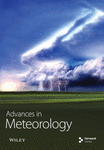Power Data Access Viewer-Based Meteorological Drought Analysis and Rainfall Variability in the Nile River Basin
Abstract
Meteorological drought poses a frequent challenge in the Nile River basin, yet its comprehensive evaluation across the basin has been hindered by insufficient recorded rainfall data. Common indices like the standard precipitation index, coefficients of variation, and precipitation concentration index serve as pivotal tools in gauging drought severity. This research aimed to assess the meteorological drought status in the Nile River basin by using the Power Data Access Viewer product rainfall data. Bias correction procedures were implemented to refine the monthly rainfall data for Bahirdar, Markos, Nekemt, and Muger stations, resulting in notable improvements in the coefficient of determination (R2) that were increased from 0.74 to 0.93, 0.72 to 0.89, 0.71 to 0.96, and 0.69 to 0.84, respectively. The average spatial distribution of drought in the Nile basin was classified as extremely wet (3.81%), severely wet (9.01%), moderately wet (7.36%), near normal (9.97%), moderately drought (21.20%), severely drought (17.11%), and extremely drought (31.54%). Approximately 10.33% of the Nile River basin was situated in regions characterized by high rainfall variability, while around 21.17% was located in areas with a notably irregular precipitation concentration index. Overall, this study sheds light on the prevailing meteorological drought patterns in the Nile River basin, emphasizing the significance of understanding and managing these phenomena for the sustainable development of the region.
1. Introduction
Drought is a recurring and severe phenomenon with significant impacts on the economy, society, and ecosystems of the world [1, 2]. Drought indices, which combine various variables like precipitation and evapotranspiration into a single numerical value, are essential for quantifying drought severity, detecting its onset and end, and planning water resources value [3]. Drought stands out as a prominent natural hazard, exerting significant consequences on agricultural output, water reserves, ecosystem dynamics, the environment, as well as both global and local economies [4].
Meteorological droughts, characterized by prolonged rainfall deficiency, can lead to agricultural droughts with soil water deficiency and reduced crop yields [5]. Analyzing rainfall variability is crucial for effective hydrological planning and management [6].
Riparian countries of the Nile River basin like Sudan, Egypt, and Ethiopia are highly vulnerable to drought due to climate change and reduced rainfall [6]. However, accessing accurate precipitation data for drought monitoring systems is challenging. The lack of climate data records in the many River basins, including the Nile River basin, hinders the interpretation of drought indices and the recommendation of drought-resilient agricultural practices. The Prediction of Worldwide Energy Resources (POWER) data access viewer (DAV) provided by NASA/POWER offers a solution by providing global weather data at a 1° latitude-longitude resolution [7], and NASA satellite production rainfall data have good accuracy [8].
While earlier research has assessed drought indices at the watershed level, the accurate evaluation of meteorological and hydrological drought in the Nile River basin has been hindered by insufficient recorded rainfall and flow data across the basin’s stations [9]. Drought indices such as the standardized precipitation index, rainfall variability, and precipitation concentration index are evaluated using the POWER data access viewer product rainfall data [10]. The POWER Data Access Viewer (DAV) furnishes gridded rainfall data in long-term, consistent time series, covering expansive geographic areas, and this includes remote or ungauged regions where on-site station data may be lacking or limited [8]. This feature is particularly beneficial for large river basins, where the precise depiction of spatial variations in rainfall is crucial [11]. The standard precipitation index (SPI) has advantages such as simplicity, standardization, and variable time scales [12]. Precipitation data are often readily available from meteorological stations, satellites, or climate models. SPI’s reliance on precipitation data enhances its applicability in data-scarce regions where obtaining comprehensive hydrological data may be challenging [13]. SPI relies solely on precipitation data and does not incorporate other climatic variables such as temperature or evapotranspiration. This limitation means that SPI may not fully capture the complexities of drought conditions, especially in regions where temperature plays a significant role in water availability [14]. The standardized precipitation index (SPI) does not take into account soil moisture, and neglecting these factors may result in an incomplete grasp of the comprehensive meteorological drought conditions [15]. The standard precipitation index (SPI) is used in large river basins despite these limitations because it provides a standardized measure of precipitation anomalies [16], making it easier to compare drought conditions across different regions and periods [17].
This study assesses meteorological drought indices, rainfall variability, and concentration index in the Nile River basin, utilizing POWER data for Ethiopia, Sudan, and Egypt. Hydrological drought analysis is excluded due to flow data limitations. The significance lies in enhancing understanding of the Nile River basin drought, offering valuable insights for assessment, and guiding climate change adaptation and mitigation strategies.
2. Materials and Methods
2.1. Description of the Study Area
The study area spans three riparian countries: Ethiopia, Sudan, and Egypt. Riparian areas are crucial as they are situated along the banks of rivers and play a significant role in ecosystems, agriculture, and water resource management. The specified coordinates (between 20°0′ and 40°0′ East and 10°0′ and 30°0′ North) indicate a substantial region, covering a wide longitudinal and latitudinal range (Figure 1). The distribution of the study area shows varying percentages in each country: 66.7% in Sudan, 18.3% in Ethiopia, and 15.0% in Egypt, and this suggests that the bulk of the study area is in Sudan, followed by Ethiopia and Egypt.

2.2. Data Analysis
2.3. Meteorological Drought Index and Rainfall Variability
| SPI value | Class |
|---|---|
| ≤−2.0 | Extremely drought |
| −1.99 to −1.49 | Severely drought |
| −1.49 to −0.99 | Moderately drought |
| −0.99 to 0.99 | Near normal |
| 1.0 to 1.49 | Moderately wet |
| 1.5 to 1.9 | Severely wet |
| ≥2.0 | Extremely wet |
| Range CV (%) | Variability category |
|---|---|
| CV < 20 | Less variability |
| 20–30 | Moderately variability |
| CV > 30 | High variability |
| Range PCI (%) | Rainfall concentration |
|---|---|
| ≤10 | Uniform precipitation distribution |
| 11–15 | Moderate precipitation distribution |
| 16–20 | High irregular precipitation distribution |
| ≥21 | Very high irregular precipitation distribution |
3. Results and Discussion
3.1. Bias Correction of Rainfall
DAV satellite product rainfall data bias exceeding 30% has the potential to considerably affect the precision and dependability of precipitation information. This underscores the necessity for corrective measures to address the bias, especially since the selected station in the current studies exhibited a bias percentage exceeding 30% [38]. Based on [39], the percentage bias of uncorrected stellate rainfall data varied from −1.4% to 63.4%. In January, the bias of Bahirdar, Markos, Nekemt, and Muger stations was −50.0%, −75.0%, −83.3%, and −33.3% (Table 4). This indicates that all stations tend to underestimate rainfall in January, with Nekemt showing the highest level of underestimation. Bahirdar, Markos, Nekemt, and Muger had biases of −66.7%, −76.0%, −66.7%, and −75.0% in February and −25.60%, −40.0%, −25.0%, and −50.0% in March, respectively, as presented in Table 4. Again, all stations exhibit underestimation, with Markos and Muger showing the highest biases, and once more, all stations tend to underestimate rainfall in March, with Muger showing the highest level of underestimation. Meteorological droughts might be underestimated or overlooked due to the underestimated rainfall data, and this can hinder early drought detection and preparedness efforts and overestimation can lead to false alarms of impending drought conditions [40]. The bias percentage in stellate product rainfall data can reach as high as −63%, with variations potentially dependent on the specific location of the study area [38]. In the current study, the maximum underestimation and overestimation biases were recorded as −83.3% and 86.4%, respectively, at the Nekemt station which was the maximum compared with earlier findings. The percentage of bias observed in the present study varied across months, even for stations with similar characteristics. The fluctuation in bias percentages within stellate product rainfall data from one month to the next can be ascribed to various factors, including seasonal patterns [41], climate oscillations, and potential errors in instrumentation and measurement processes [42]. The percentage of bias in the current study varied from one station to another station which may be due to the location of the station, local climate characteristics, and the quality of ground-based gauged rainfall data used for comparison. These biases highlight the importance of considering station-specific bias correction when using satellite rainfall data for various applications in different regions.
| Station | Jan | Feb | Mar | Apr | May | Jun | Jul | Aug | Sep | Oct | Nov | Dec |
|---|---|---|---|---|---|---|---|---|---|---|---|---|
| Bahirdar | −50.0 | −66.7 | −25.6 | 43.8 | 67.8 | −31.4 | −35.4 | 31.8 | 51.5 | −69.6 | −36.2 | −35.5 |
| Markos | −75.0 | −76.0 | −40.0 | 58.9 | 68.7 | −33.3 | −35.6 | 36.2 | 49.8 | −77.2 | −35.3 | −40.5 |
| Nekemt | −83.3 | −66.7 | −25.0 | 63.6 | 86.4 | −23.6 | −35.2 | 40.3 | 43.9 | −58.1 | −35.6 | −65.5 |
| Muger | −33.3 | −75.0 | −50.0 | 43.8 | 45.7 | −17.7 | −3.9 | 41.0 | 51.5 | −79.1 | −35.5 | −45.5 |
In Bahirdar station, the R2 values improved from 0.74 to 0.93 after bias correction, indicating a significant enhancement in the correlation between rainfall data that is described in Figures 2(a) and 2(b). Similarly, in Markos station, the R2 values increased from 0.72 to 0.89 after bias correction, indicating a notable improvement in the correlation of rainfall data (Figures 2(c) and 2(d)). The R2 values in the Nekemt station were improved from 0.71 to 0.96 after bias correction, suggesting a substantial enhancement in the correlation between rainfall data in the Nekemt station as presented in Figures 2(e) and 2(f). Lastly, the R2 values of Muger station were increased from 0.69 to 0.84 after bias correction, indicating a considerable improvement in the correlation of rainfall data as described in Figures 2(g) and 2(h). The minimum value of coefficients of determination after bias correction (R2) was 0.84 which indicates a better fit between observed and DAV rainfall. The findings indicate the effectiveness of the correction method in improving the accuracy of the satellite-derived rainfall data [39]. All evaluated coefficients of determination (R2) after bias correction showed that DAV rainfall data were in a high linear relationship with the data measured from the precipitation observation station. Overall, the results demonstrate that bias correction techniques have successfully improved the correlation between rainfall data in all four stations.


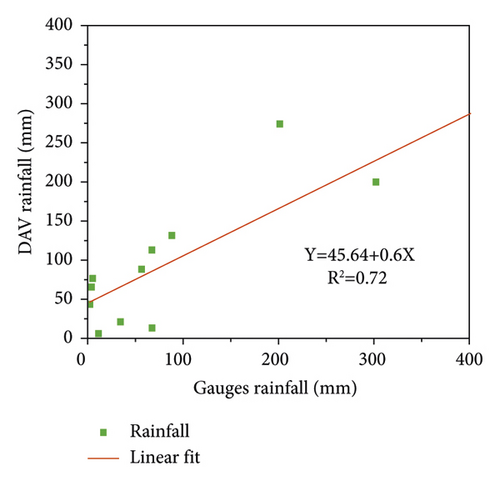
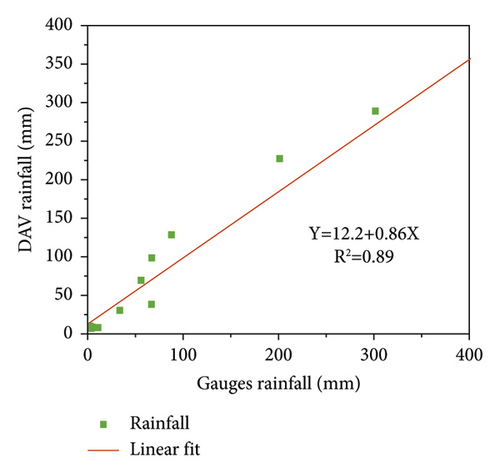
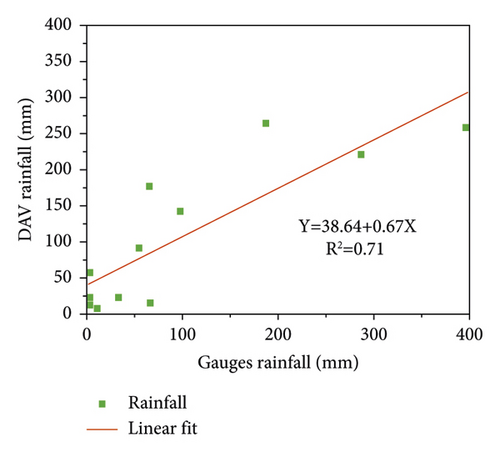

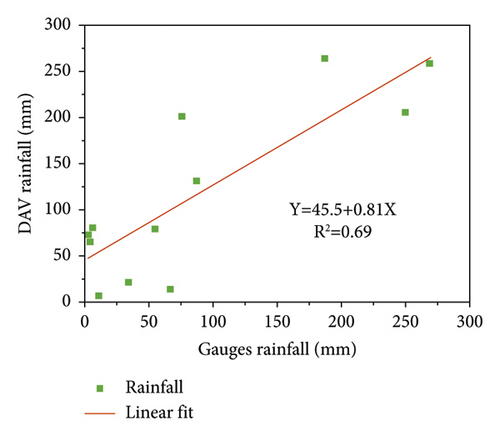
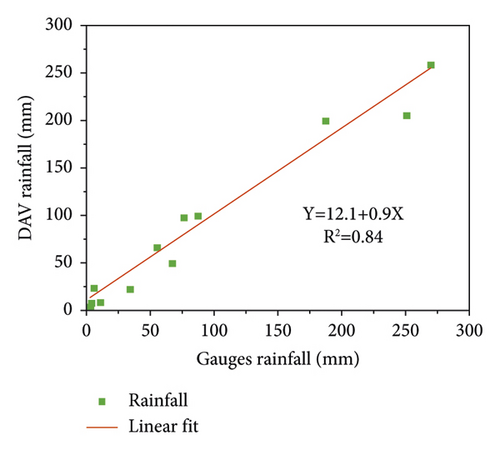
After bias correction, the spatial annual rainfall distribution was interpolated through the Nile River basin as discussed in Figure 3. The average annual rainfall across the Nile River basin exhibited considerable variability, ranging from 0.65 mm in Egypt to 1455.5 mm in Ethiopia, and the result showed that the amount of annual rainfall in the Nile River basin decreased from Ethiopia toward Egypt. The observed variation in average annual rainfall across the Nile River basin can be attributed to several climatic and geographical factors. Ethiopia was located at the headwaters of the Nile, experiencing a more diverse and elevated topography, contributing to higher precipitation levels. In contrast, downstream Sudan and Egypt grapple with a more arid climate and lower elevations, resulting in diminished annual rainfall. This spatial distribution in the basin is used to understand regional variations in rainfall within the area to suggest possible mitigation measures [34].
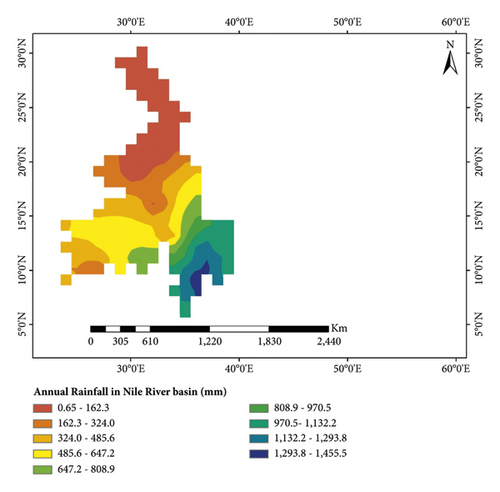
3.2. Standardized Precipitation Index
The research conducted involved a historical analysis of the standard precipitation index (SPI) for stations located in the Nile basin from 2001 to 2021. During the period from 2007 to 2009, the Nile River basin exhibited the highest coverage under extreme drought conditions, reaching a maximum of 35% as presented in Figure 4(c). This observation suggests a heightened susceptibility of the basin to arid conditions during that specific time frame. In contrast, the availability of extreme wetlands from 2018 to 2021 (Figure 4(g)) experienced a notable reduction of 16.7% when compared to the climate scenario observed between 2001 and 2003 (Figure 4(a)). This decline emphasizes a significant alteration in the hydrological conditions of the basin, indicative of a changing climate landscape. The spatial distribution of meteorological drought within the Nile basin revealed distinct percentages associated with various drought categories. A minimal area (3.81%) of the Nile River basin experienced extremely wet conditions, indicating regions with an abundance of precipitation. A significant portion of the Nile River basin (9.01%) was experiencing severely wet conditions. Wetness characteristics of the basin could lead to issues such as flooding, soil erosion, and potential impacts on agriculture and infrastructure [43], and understanding the causes of severe wetness is important for water resource management and disaster preparedness [44]. Another substantial part of the basin exhibits moderate wetness (7.36%). While not as extreme as severe wetness, this still indicates a notable surplus of water. Moderate wet conditions can influence water availability and ecosystem health and may have implications for various sectors, including agriculture and water supply [45]. Approximately 9.97% of the Nile River basin was currently experiencing drought conditions classified as near normal. The near-normal drought suggests that the conditions are drier than average but not to an extreme extent [46].
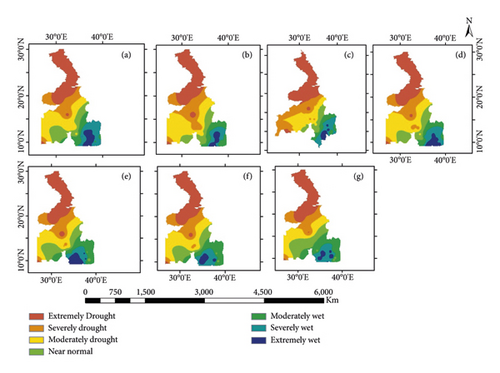
In this study, the result was that approximately 21.20% of the Nile River basin exhibited conditions indicative of moderate drought, pointing towards a substantial reduction in precipitation. This important finding highlights the impact of climatic variations on the hydrological dynamics of the region, shedding light on the vulnerabilities within the Nile River basin. The classification of moderate drought in a significant proportion of the basin emphasizes the pressing need for adaptive water resource management strategies to mitigate potential adverse effects on ecosystems and human activities [47]. The reported result indicating that 17.11% of the Nile River basin was experiencing severe drought conditions suggests a heightened and critical shortage of water availability in this specific geographic area. Drought conditions are often characterized by an extended period of below-average precipitation coupled with increased evaporation, leading to a deficit in water resources [48]. The classification of 31.54% of the Nile River basin as extremely drought-prone emphasizes the critical need for effective water management strategies, sustainable land use practices, and climate-resilient policies to address and mitigate the impacts of severe water scarcity in these areas, especially within the latitude range of 20°0′0″ to 30°0′0″ North. The observed spatial distribution of drought highlights the heterogeneity of climatic conditions within the Nile basin [40]. Variation of standard precipitation index in Nile River basin may be due to climate change and human activity influence [49]. The annual value of the standard precipitation index indicated that the Nile River basin in Sudan and Egypt tributaries received several drought events, and the most severe event was during the year 1984 [50].
Notably, the region of the Nile River basin in Egypt was presently undergoing an extreme drought, indicating a severe lack of precipitation that posed substantial challenges to water availability and agriculture throughout the Nile River basin. In Sudan, the drought status of the Nile basin varied across the spectrum from near normal to extremely dry, highlighting a mixed scenario where some areas experienced regular precipitation while others faced severe drought conditions. Meanwhile, the Nile River basin in Ethiopia (called as Upper Blue Nile basin) exhibited predominantly wet to moderately wet conditions, suggesting an excess of rainfall that could have positive implications for water availability and agriculture in the Nile River basin. These results highlight the importance of region-specific water management strategies and the need for continuous monitoring to address the diverse hydrological challenges faced by different parts of the Nile basin. Further research and proactive measures are essential to mitigate the impacts of drought, particularly in regions experiencing extreme conditions, and to enhance the overall resilience of the Nile River basin to varying climatic patterns.
3.3. Drought Duration and Frequency
The duration and frequency of droughts in the Nile River basin exhibited significant variability across different regions within the study period. Specifically, in Ethiopia, there were instances where no drought was observed (0 months), whereas in Egypt, drought durations extended up to 12 months (Figure 5(a)). In addition, the frequency of these drought events ranged from none (0 occurrences) to as many as 21 times throughout the period of study (Figure 5(b)). Analysis of annual SPI (standardized precipitation index) data reveals a greater prevalence of drought conditions in Egypt, and these dry periods were notably observed in the mid-1960s, from 1968 to 1972, between 1981 and the early 1980s, during the mid-1980s, and from 1989 through 1998 [51]. These data indicate a notable trend, particularly in Egypt, where the number of drought occurrences corresponded directly to the length of the study period. This implies that, on average, the Nile River basin in Egypt encountered a minimum of one drought annually within this timeframe, in contrast to the basin extent in Ethiopia.
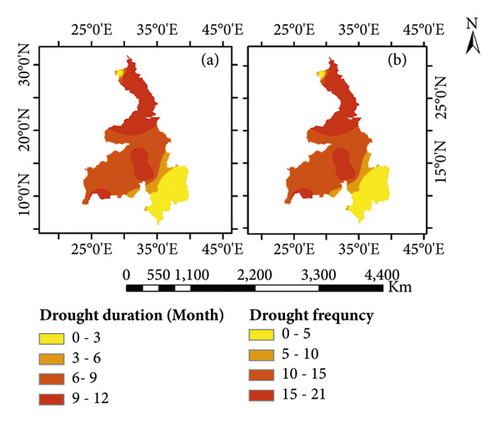
3.4. Coefficient of Variation and Precipitation Concentration Index
The research findings reveal a noteworthy increase in rainfall variability across the Nile River basin. Monthly rainfall amounts in Sudan and Egypt were significantly lower when compared to Ethiopia, indicating a spatial gradient in precipitation variability. In the subset characterized by less rainfall variability (59.1%), an in-depth analysis reveals a prevailing trend of stability in rainfall patterns. This suggests a certain level of predictability and consistency in precipitation levels within this substantial portion of the basin. In contrast, the category associated with moderate rainfall variability (30.57%) signifies a more dynamic environment where precipitation levels exhibit a moderate degree of fluctuation. This middle range suggests a balanced interplay of meteorological factors, potentially influencing the ecological and hydrological systems in a way that requires closer scrutiny. The remaining portion of the Nile River basin characterized by high rainfall variability (10.33%) denotes a region facing pronounced and potentially erratic changes in precipitation. This subset demands focused attention due to the heightened sensitivity of ecosystems and water resources to variations in rainfall, which may have significant implications for both local environments and regional hydrology in Figure 6(a).
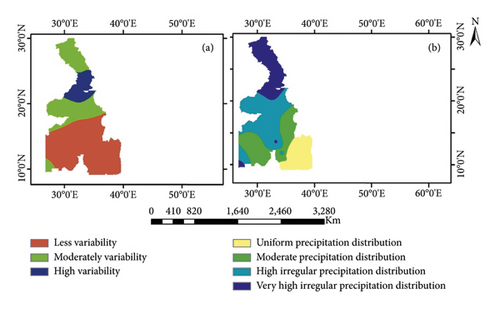
The Nile River basin exhibits significant variability in rainfall, particularly in Sudan and Egypt, especially within the latitude range of 22°0′ to 25°0′ North and this region experiences notable fluctuations in precipitation levels. The mean coefficients of variation for the wet season, dry season, and annual precipitation in the Upper Blue Nile River basin (in Ethiopia) between 1901 and 2000 were 8.8%, 11.4%, and 7.5%, respectively. These values, all below 20%, suggest relatively less variability in rainfall availability [52]. In the recent investigation covering the years 2001–2021, a similar trend of less rainfall variability was observed in the Blue Nile River basin, which constitutes a portion of the larger Nile basin. This consistency implies a continued pattern of relatively stable precipitation levels in the region. This study contributes to the existing knowledge of rainfall variability in the Nile River basin, highlighting the spatial differences observed across Ethiopia, Sudan, and Egypt. The identified categories of variability serve as a valuable tool for water resource planners and policymakers to develop targeted strategies for sustainable water management and climate resilience in the region [53].
Based on the precipitation concentration index, the analysis reveals that 34.61% of the study area experiences a high irregular distribution of precipitation (Figure 6(b)). This indicates areas where precipitation events are sporadic and exhibit significant variability. In addition, 27.70% of the area demonstrates a moderate precipitation distribution, suggesting a more balanced but still variable pattern. Notably, 21.17% of the region exhibits very high irregular distribution, emphasizing areas with extreme fluctuations in precipitation levels. A smaller percentage, 16.52%, was characterized by a uniform distribution of precipitation, indicative of regions with consistent and evenly distributed rainfall. In the Upper Blue Nile River basin, the annual precipitation concentration index ranges from 11.43% to 28.39%, with an average of 21.41%. This average signifies a moderate distribution of rainfall in the area [54], and the current study observed variability of the upper reach of the Nile River basin (in Ethiopia) ranging from uniform to moderate distribution. The precipitation concentration index of the Nile River basin increased from Ethiopia toward Sudan and Egypt. In contrast, the precipitation concentration in Sudan and Egypt indicates an erratic distribution of rainfall in these regions, and the precipitation distribution pattern within the Nile River basin in Egypt exhibits a highly irregular nature. A considerable portion of the Nile River basin in Sudan displays a distinct high level of irregularity in precipitation distribution, especially when compared to other classification patterns. Understanding the precipitation concentration index is important for assessing the variability and reliability of rainfall patterns, which has implications for water resource management, agriculture, and other sectors in the region [55]. Both rainfall variability and concentration vary due to factors like land use changes, water bodies [56], geography, and topography [57].
4. Conclusion and Recommendation
- (1)
This study focused on evaluating meteorological drought, rainfall variability, and the precipitation concentration in the Nile River basin, utilizing rainfall data from the Power Data Access Viewer for the period 2001–2021. In order to enhance the accuracy of the analyses involving the abovementioned indices, a rigorous bias correction process was employed on the satellite-derived rainfall data, ensuring its alignment with data from selected meteorological stations.
- (2)
The application of bias correction on the satellite-derived rainfall data within the Data Access Viewer yielded a notable 26.6% enhancement in the R2 value. This improvement shows a substantial increase in the accuracy of the satellite product for rainfall. Following the bias correction, the spatial distribution of annual rainfall across the Nile River basin showcased significant variability, ranged from 0.65 mm in Egypt to 1455.5 mm in Ethiopia.
- (3)
Based on the standard precipitation index, approximately 30.15% of the Nile River basin displayed a spectrum of conditions, ranging from extremely wet to near normal. On the other hand, a substantial portion, accounting for 69.85% of the total area, exhibited variations indicative of moderate to extreme drought that show available monthly or annual rainfall was minimal compared with the long-term mean value of rainfall. The maximum extent of extreme drought conditions observed from the 2007 to 2009 time period covered an average of 35% of the Nile basin. The duration and frequency of droughts in the Nile River basin also increased from Ethiopia towards Sudan and Egypt.
- (4)
In the study of the basin’s rainfall patterns, it was found that approximately 59.1% of the area demonstrates a lower variability in precipitation, indicating a more uniform and predictable pattern of rainfall. On the other hand, the precipitation concentration index indicates that 34.61% of the basin is characterized by a markedly uneven distribution of rainfall, pointing to a greater degree of unpredictability in precipitation trends.
- (5)
Future research should explore the drivers and impacts of extreme droughts in the Nile River basin, focusing on adaptive strategies for water resource management in vulnerable areas.
Conflicts of Interest
The author declares that there are no conflicts of interest.
Acknowledgments
The author wants to acknowledge and convey his profound gratitude to the National Aeronautics and Space Administration (NASA), the provider of Power Data Access Viewer.
Open Research
Data Availability
The data used to support the findings of this study are made available from the corresponding author upon reasonable request.



